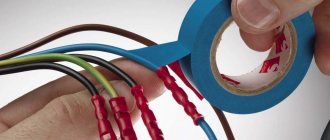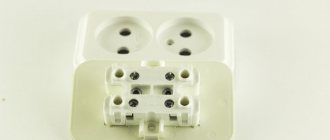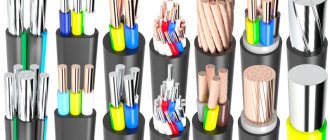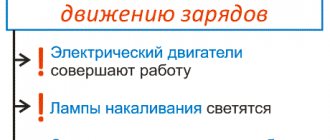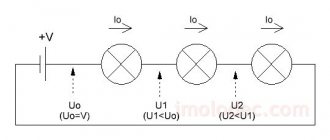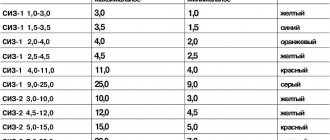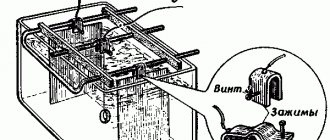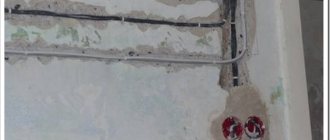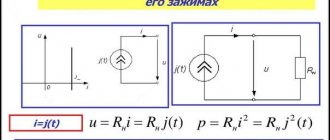In air, copper wires oxidize slowly, becoming covered with a thin layer of CuO oxide, which prevents further oxidation of copper. Copper corrosion is caused by sulfur dioxide SO2, hydrogen sulfide H2S, ammonia NH3, nitric oxide NO, nitric acid vapor and some other reagents.
Conducting copper is obtained from ingots by galvanic purification in electrolytic baths. Impurities, even in insignificant quantities, sharply reduce the electrical conductivity of copper, making it unsuitable for current conductors, therefore only two grades of copper, M0 and M1, are used as electrical copper.
Almost all conductive copper products are made by rolling, pressing and drawing. Thus, wires with a diameter of up to 0.005 mm, tapes with a thickness of up to 0.1 mm, and copper foil with a thickness of up to 0.008 mm can be produced by drawing.
Conducting copper is used both in annealed form after cold working (soft copper grade MM) and without annealing (hard copper grade MT).
At heat treatment temperatures above 900 °C, due to intensive grain growth, the mechanical properties of copper sharply deteriorate.
In order to increase the creep strength and thermal stability, copper is alloyed with silver in the range of 0.07-0.15%, as well as magnesium, cadmium, zirconium and other elements.
Copper with silver additives is used for windings of high-speed and heat-resistant high-power machines, and copper alloyed with various elements is used in commutators and slip rings of heavily loaded machines.
Characteristics of electrical materials
The main characteristic in electrical engineering is the specific electrical conductivity, measured in S/m. It serves as a coefficient of proportionality between the field strength vector and the current density. Often denoted by the Greek letter gamma γ. Specific resistance is recognized as the reciprocal of electrical conductivity. As a result, the formula mentioned above takes the form: current density is directly proportional to the field strength and inversely proportional to the resistivity of the medium. The unit of measurement becomes Ohm m.
The concept under consideration remains relevant not only for solid media. For example, electrolyte liquids and ionized gases conduct current. Consequently, in each case it is permissible to introduce the concept of resistivity, because an electric charge passes through the medium. Finding values in reference books, for example, for a welding arc is difficult for a simple reason - such tasks are not sufficiently addressed. This is not required. A century passed from the moment Davy discovered the heating of a platinum plate with an electric current until the introduction of incandescent light bulbs into everyday life - for a similar reason, the importance and significance of the discovery was not immediately realized.
Material property
Depending on the value of the resistivity, materials are divided:
- For conductors - less than 1/10000 Ohm m.
- Dielectrics have over 100 million ohm m.
- Semiconductors in terms of resistivity values are between dielectrics and conductors.
These values characterize solely the body’s ability to resist the passage of electric current and do not affect other aspects (elasticity, heat resistance). For example, magnetic materials are conductors, dielectrics and semiconductors.
How conductivity is formed in a material
In modern physics, resistance and conductivity are usually explained by the band theory. It is applicable to solid crystalline bodies whose lattice atoms are assumed to be stationary. According to this concept, the energy of electrons and other types of charge carriers is determined by established rules. There are three main zones inherent in the material:
- The valence band contains electrons bound to atoms. In this region, the electron energy is graded in steps, and the number of levels is limited. The outermost layer of the atom.
- Prohibited area. Charge carriers are not allowed to be in this region. Serves as the boundary between two other zones. Metals are often absent.
- The free zone is located above the previous two. Here electrons participate freely in the creation of electric current, and the energy is any. No levels.
Dielectrics are characterized by the highest location of the free zone. Under any natural conditions imaginable on Earth, materials do not conduct electric current. The width of the forbidden zone is also large. Metals have a lot of free electrons. And the valence band is simultaneously considered a conduction region - there are no forbidden states. As a result, such materials have low resistivity.
Calculation of beats resistance
At the interface of atomic contacts, intermediate energy levels are formed, and unusual effects used in semiconductor physics arise. Heterogeneities are created deliberately by the introduction of impurities (acceptors and donors). As a result, new energy states are formed, which exhibit new properties during the flow of electric current that the original material did not possess.
Semiconductors have a small band gap. Under the influence of external forces, electrons are able to leave the valence region. The cause is electrical voltage, heating, radiation, and other types of influences. In dielectrics and semiconductors, as the temperature decreases, electrons move to lower levels, as a result, the valence band is filled, and the conduction band remains free. Electric current does not flow. In accordance with quantum theory, the class of semiconductors is characterized as materials with a band gap of less than 3 eV.
Let's move on to dielectrics
A dielectric is a matter that is not subject to the influence of an electric field, that is, it does not pass current through itself, and if it does, it is in an insignificant amount.
This happens because they do not have freely moving particles - current carriers, since they have a very strong atomic bond.
In life, such substances are rubber, ceramic components, glass, certain types of resins, distilled water, carbonite, porcelain, textolite, as well as dry wood and so on.
It is thanks to their properties that the above materials are the basis for the housings of various electrical appliances, switches, sockets, plugs and other devices that come into direct contact with electricity.
Insulating elements in networks are also made of dielectric materials.
But not everything is so simple with dielectrics. If you pass a higher current through them, store them or install them in an environment with high humidity, or use them incorrectly, you can cause a phenomenon called “insulator breakdown” - this means that the dielectric material loses its non-conductive functions and becomes a conductor.
That is, to describe the situation in a nutshell, the main thing in a dielectric is its electrical insulating abilities. Thus, these devices help us protect ourselves from the traumatic effects of electricity.
The properties of a dielectric are measured by its electrical strength - this is an indicator that is equal to the breakdown voltage of the dielectric.
Fermi energy
Fermi energy occupies an important place in the theory of conductivity and explanations of phenomena occurring in semiconductors. Adding to the secrecy is the vague definition of the term in the literature. Foreign literature says that the Fermi level is a certain value in eV, and the Fermi energy is the difference between it and the smallest one in the crystal. Here are selected general and understandable proposals:
- The Fermi level is the maximum of all those inherent to an electron in metals at a temperature of 0 K. Therefore, the Fermi energy is considered to be the difference between this figure and the minimum level at absolute zero.
- Fermi energy level - the probability of finding electrons is 50% at all temperatures except absolute zero.
The Fermi energy is determined exclusively for a temperature of 0 K, while the level exists under any conditions. In thermodynamics, the concept characterizes the total chemical potential of all electrons. The Fermi level is defined as the work required to add a single electron to an object. The parameter determines the conductivity of the material and helps to understand the physics of semiconductors.
The Fermi level does not necessarily exist physically. There are known cases when the location was in the middle of the forbidden zone. Physically, the level does not exist; there are no electrons there. However, the parameter is noticeable using a voltmeter: the potential difference between two points in the circuit (readings on the display) is proportional to the difference in the Fermi levels of these points and inversely proportional to the charge of the electron. Simple addiction. It is permissible to link these parameters with conductivity and resistivity using Ohm’s law for a section of the circuit.
Solders
Soldering is the process of joining two parts using solder, a material with a melting point lower than that of the parts being joined.
For example, connecting two copper conductors using tin. It is the use of solder that is the main difference from welding, when parts are joined by a melt from themselves, for example, a steel hook is welded to a steel door using a steel consumable welding electrode. Solders are often classified into two groups - refractory (melting point 400°C or more) and low-melting. Or, sometimes, hard and soft. Considering that soft solders are usually low-melting, hard solders are often synonymous with refractory, and soft solders are synonymous with low-melting.
In electronics, solders are used to create reliable electrical contacts. The main solders in electronic technology are soft, based on tin and tin-lead alloys. All other exotic solders will not be considered.
Low resistivity materials
Conductors include most metals, graphite, and electrolytes. Such materials have low resistivity. In metals, positively charged ions form lattice sites surrounded by a cloud of electrons. They are usually called common because they are part of the conduction band.
Although it is not entirely clear what an electron is, it is usually described as a particle moving inside a crystal with a thermal speed of hundreds of km/s. This is much more than is needed to put a spacecraft into orbit. At the same time, the drift speed, which forms an electric current under the influence of the voltage vector, barely reaches a centimeter per minute. The field propagates in the medium at the speed of light (100 thousand km/s).
As a result of these relationships, it becomes possible to express specific conductivity through physical quantities (see figure):
Formula for calculations
- Electron charge, e.
- Free carrier concentration, n.
- Electron mass, me.
- Thermal speed of carriers,
- Electron mean free path, l.
The Fermi level for metals lies in the range of 3 – 15 eV, and the concentration of free carriers is almost independent of temperature. Therefore, specific conductivity, and therefore resistance, is determined by the structure of the molecular lattice and its closeness to the ideal, freedom from defects. The parameters determine the mean free path of electrons; they are easy to find in reference books if you need to make calculations (for example, to determine resistivity).
Metals with a cubic lattice have the best conductivity. This also includes copper. Transition metals are characterized by much higher resistivity. Conductivity decreases with increasing temperature and at high AC frequencies. In the latter case, a skin effect is observed. The dependence on temperature is linear above a certain limit named after the Dutch physicist Peter Debye.
Not so straightforward dependencies are also noted. For example, heat treatment of steel increases the number of defects, which naturally reduces the specific conductivity of the material. The exception to the rule was annealing. The process reduces the density of defects, due to which the resistivity decreases. Deformation has a clear effect. For some alloys, mechanical processing leads to a noticeable increase in resistivity.
Volume representation of a property
Tin
Sn - Tin.
The main component of soft solders. Tin is a relatively low-melting metal, which makes it suitable for connecting conductors. It is not used in its pure form (see facts). Due to the high cost of tin (as well as other reasons, see below), it is diluted with lead in solders. Solder made of 61% tin and 39% lead forms a eutectic; with such a mixture, POS-61 (Tin-Lead Solder - 61% tin), radio components on boards and wires are soldered. In less critical components (chassis, heat sinks, screens, etc.), tin in solders is diluted more strongly, up to 30% tin, 70% lead.
Electronic devices have been soldered with tin-lead solders for a long time. Then environmentalists came running and said that lead is a heavy, toxic metal, and there would be no problem if all your iPhones, computers and other gadgets did not end up in a landfill, from where lead enters the environment. Therefore, they came up with a series of lead-free solders, when tin is diluted with bismuth, or is used in its pure form, stabilized by additives, for example, silver. But these solders are more expensive, have worse characteristics, and are more refractory. Therefore, tin-lead solders will remain for a long time in critical products for military, space, and medical applications.
In addition, lead-free solders are prone to whiskers. Tin whiskers - long thin crystals growing from tin solder - are the cause of equipment failures and malfunctions. Unfortunately, additives in solders do not allow 100% to stop the growth of “whiskers”, so tin-lead solders, as time-tested, are used in critical systems - space, medicine, military, nuclear applications. Read more about mustaches.
Tin Facts
- Pure tin is susceptible to “tin plague,” when at temperatures below 13.2 °C the tin changes its crystal lattice, turning from a shiny metal to a gray powder (as diamond turns to graphite when heated). According to stories, the tin plague is one of the reasons for the defeat of Napoleon’s army in the harsh conditions of Russian cities (imagine how your buttons, spoons, forks, and mugs turn into gray powder in the cold). And it is a well-established fact that the tin plague was one of the reasons that destroyed Scott’s expedition - tin cans and fuel containers were soldered with tin and simply fell apart in the cold. A small addition of bismuth virtually eliminates the tin plague.
- Tin conducts electricity 7 times worse than copper.
- Tin is used as a protective coating for cans - tinned tin does not make it dangerous in contact with food. (but since tin is to the right of iron in the series of tensions of metals, tinning does not protect iron from corrosion galvanically, like zinc, which is to the left of iron in the series of tensions. You can read how galvanic protection works at the link).
- Before the widespread use of aluminum, foil was made from tin, it was called “staniol” (from stannum - the Latin name for tin).
- Do not attempt to repair jewelry with soft tin or tin-lead solders. The strength of the connection will be unacceptable, and the presence of low-melting solder on the surface will complicate normal brazing.
Low melting point solders
Low-melting solders were developed based on alloys containing tin. And even very low-melting solders that melt in hot water. There is a good list of alloys on Wikipedia.
Coils and rods of tin-lead solders. The solder wire contains a central channel containing flux to facilitate the soldering process.
Basic solders for radio equipment
- POS-61 - 61% tin, the rest is lead. Melting point (liquidus) 183 °C. There are many imported solders that are similar in composition and properties, in which the proportions of the components differ by a couple of percent, for example Sn60Pb40 or Sn63Pb37.
- POS-40 - 40% tin. The rest is lead. Melting point (liquidus) 238 °C Less durable, more refractory, non-eutectic (does not melt immediately, there is a temperature range at which solder is more like mush). But due to the fact that it is almost half the price (tin is expensive), it is used for non-critical connections - soldering screens and busbars. Similar solders are POS-33 (melting point 247C), POS-25 (melting point 260C), POS-15 (melting point 280C).
- Lead-free solders. To solder copper water pipes with a torch, soft solder with 3% copper (Sn97Cu3) is most often used. It does not contain lead and is therefore suitable for drinking water. For environmental reasons, modern electronics in factories are soldered mainly with lead-free solders. Good article.
Complete the list with very low-melting solders:
- Rose alloy: 25% Sn, 25% Pb, 50% Bi. Melting point +94 °C.
- Wood's alloy: 12.5% Sn, 25% Pb, 50% Bi, 12.5% Cd Melting point +68.5 °C.
They are used for tinning printed circuit boards by amateurs, as they melt in hot water, and you can quickly coat the copper foil of the printed circuit board with a rubber spatula under a layer of boiling water.
In technology, they are used for soldering parts that cannot withstand heating to the usual temperature of solders, or in cases where for some reason a very low-melting metal is needed (for example, for a temperature sensor). If you solder the spring-loaded contacts with low-melting solder, you will get a simple and reliable thermal fuse; when the temperature is exceeded, the solder melts and the contacts break the circuit. True, the fuse will be disposable. In many Soviet televisions, the horizontal scanning unit had protection made of an ordinary steel spiral spring, soldered with low-melting solder. When overheated, including from a high current through the spring, it would unsolder and come off. Fuses of this type are very good as fire protection.
High resistivity materials
Sometimes it is necessary to specifically increase the resistivity. A similar situation occurs in cases with heating devices and resistors in electronic circuits. That’s when it’s time for alloys with high resistivity (more than 0.3 μOhm m). When used as part of measuring instruments, there is a requirement for a minimum potential at the interface with the copper contact.
Nichrome is the most famous. Heating devices are often constructed from cheap fechral (fragile, but cheap). Depending on the purpose, the alloys include copper, manganese and other metals. This is an expensive pleasure. For example, a manganin resistor costs 30 cents on Aliexpress, where prices are traditionally lower than store prices. There is even an alloy of palladium and iridium. The price of the material should not be spoken out loud.
PCB resistors are often made from pure metals in the form of films by sputtering. Chromium, tantalum, tungsten, alloys, among other things, nichrome are widely used.
Basics of electroacoustics
Conducting materials Solid conductors of electric current are metals, metal alloys and some modifications of carbon. Among metal conductors there are: materials with high conductivity, which are used for the manufacture of wires and cables; conductive connections in microcircuits, transformer windings, waveguides, etc.; metals and alloys with high resistance, which are used for the manufacture of electric heating devices, resistors, rheostats for incandescent lamps, etc.
Properties of conductor materials. The main electrical parameters of conductor materials are
- specific conductivity (or its inverse value - resistivity)
- temperature coefficient of resistivity.
The mechanical properties of conductors are characterized by tensile strength and elongation at break. Such physical parameters as density, melting point, etc. are well known.
The resistivity p of a conductor having a constant cross-section S and length l is determined by the formula p = RS/l and is expressed in ohms per meter (Ohm-m). To measure the resistivity of conductors, the non-system unit Ohm-mm2/m is used (S is measured in mm2, l - in m); 1 Ohm-m=106 Ohm-mm2/m. Fractional of the system unit 1 μΩ-m = 1 Ω-mm2/m. We will express the resistivity of the conductors in µOhm-m, while maintaining the usual numerical values p.
The temperature coefficient of resistivity shows how a resistance of 1 ohm changes with a change in temperature of one degree. The physical parameters of semiconductor materials are given in table. 1.
| Metal | Density, Mg/m3 | Temperature, melting point, °C | Resistivity, µOhm-m | Temperature coefficient specific resistance. | work function, eV |
| Aluminum | 2,7 | 660 | 0,0265 | 4,1 | 4,25 |
| Tungsten | 19,3 | 3400 | 0,055 | 5,0 | 4,54 |
| Iron | 7,87 | 1540 | 0,097 | 6,25 | 4,31 |
| Gold | 19,3 | 1063 | 0,0225 | 3,95 | 4,3 |
| Cobalt | 8,85 | 1500 | 0,064 | 6,0 | 4,41 |
| Copper | 8,92 | 1083 | 0,0168 | 4,3 | 4,4 |
| Molybdenum | 10,2 | 2620 | 0,05 | 4,33 | 4,3 |
| Nickel | 8,96 | 1453 | 0,068 | 6,7 | 4,5 |
| Tin | 7,29 | 232 | 0,113 | 4,5 | 4,38 |
| Platinum | 21,45 | 1770 | 0,098 | 3,9 | 5,32 |
| Mercury | 13,5 | — 39 | 0,958 | 0,9 | 4,52 |
| Lead | 11,34 | 327 | 0,190 | 4,2 | 4,0 |
| Silver | 10,49 | 961 | 0,016 | 4,1 | 4,3 |
| Chromium | 7,19 | 1900 | 0,13 | 2,4 | 4,58 |
| Zinc | 7,14 | 419 | 0,059 | 4,1 | 4,25 |
The resistivity of thin metal films (the thickness of which is commensurate with the electron mean free path) is greater than the resistivity of the original metal and depends on the thickness and method of producing the films. The conductive properties of thin films are assessed by the specific surface resistance (resistance of the square), equal to the resistance of a section of the film, the length of which is equal to its width when current passes through its two opposite faces parallel to the surface of the substrate Rп =рб/б, where Рb is the specific (volume) resistance of the film . The resistivity of alloys is greater than the resistivity of the original components. An increase in p occurs when non-metallic impurities are introduced into the metal, as well as when two metals are fused to form a solid solution in which atoms of one metal enter the crystal lattice of the other.
Technical conductor materials are divided into
- high conductivity materials,
- metals and alloys for various purposes,
- high resistance alloys,
- conducting modifications of carbon and materials based on them.
Materials of high electrical conductivity . The most common materials with high electrical conductivity include copper and aluminum (see Table 1).
Copper has low resistivity, high mechanical strength, satisfactory corrosion resistance, is easily soldered, welded and well processed, which allows it to be rolled into sheets, tape and drawn into wire.
Copper grades Ml and MO are used as conductor material. The Ml grade contains 99.9% pure copper, and in the total amount of impurities (0.1%) oxygen is up to 0.08%. “The second grade has the best mechanical properties, which contains 99.95% copper, and the impurities (0.05%) there is up to 0.02% oxygen. The best oxygen-free copper contains 99.97% pure substance, and vacuum (melted in vacuum induction furnaces) - 99.99. %. Hard-drawn copper, obtained by cold drawing, is used when high mechanical strength is required, and soft (annealed) copper is used when flexibility is important, for example, for the manufacture of installation wires and cords. Electrovacuum copper is used for the manufacture of parts for electronic devices. Copper is also used for the manufacture of foil getinax, and in microelectronics for the production of conductive films on substrates that provide connections between functional elements of the circuit. The most common brands of winding wires are given in table. 2.
| Wire brand | Insulation characteristics | Wire diameter, mm |
| PEL | Enamel varnish resistant | 0,02 — 2,44 |
| PEV-1 | Enamel with single and double viniflex coating | 0,06 — 2,44 |
| PALBO | Enamel paint-resistant with one layer of cotton winding | 0,2-2,1 |
| P-ELBD | The same, but with two layers of cotton winding | 0,72 — 2,1 |
| palsho | The same, but with one layer of silk winding | 0,05-2,1 |
| paleshd | Enamel varnish-resistant with two layers of silk winding | 0,86 |
| PELSHKO | Enamel paint-resistant with one layer of nylon winding | 0,05-2,1 |
| palshkd | Enamel paint-resistant with two layers of nylon winding | 0,86 |
| PELBV | Enamel paint-resistant with long-fiber paper wrapping | 0,51 — 1,45 |
| Air defense | One layer of cotton winding | 0,2 — 2,1 |
| PBD | Two layers of cotton winding | 0,2 — 5,2 |
Bronze is an alloy of copper with a small amount of tin, silicon, phosphorus, chromium, cadmium or other materials, which has higher mechanical properties than copper. Widely used for the manufacture of conductive springs. Brass is an alloy of copper with zinc and other additives, which has a high relative elongation, which is important when processing by stamping and deep drawing. Used for the manufacture of various conductive parts.
The composition and properties of some copper electrical alloys are given in Table. 3.Table 3
| Alloy | Specific conductivity,% to copper | Tensile strength, MPa | Elongation at break, % |
| Cadmium bronze (0.9% Cd) | 95 | Up to 310 | 50 |
| Bronze (0.8% Cd; 0.6% Sn) | 55 — 60 50—55 | 290 To 730 | 55 4 |
| Phosphor bronze (7% Sn; 0.1% P) | 10 — 15 | Up to 400 | 60 |
| Brass (70% Cu; 30% Zn) | 25 | 320 — 350 | 70 |
Aluminum is approximately 3.5 times lighter than copper. For electrical purposes, aluminum of technical purity AE is used, containing up to 0.5% impurities. A wire made of AE aluminum and annealed at a temperature of 350 °C has a resistivity of 0.028 μOhm*m. High-purity aluminum A97 (impurities up to 0.03%) is used for the manufacture of thin (up to 6 microns) foil, electrodes and housings of electrolytic capacitors.
Aldrey is an alloy of aluminum with magnesium (0.3 - 0.5%), silicon (0.4 - 0.7%). and iron (0.2 - 0.3%). It retains the lightness of pure aluminum (density 2.7 Mg/m3), has a resistivity close to it (0.0317 μOhm-m) and high (close to hard-drawn copper) mechanical strength.
Metals and alloys for various purposes . Below we consider metals and alloys used in electrical engineering and radio electronics. Based on the melting point, common characteristics and scope of application, refractory and noble metals, metals with medium and low melting points, solders and fluxes are distinguished.
Refractory metals have a melting point above 1700 °C, are chemically stable at low temperatures and active at high temperatures, therefore at elevated temperatures they are used in a vacuum or an atmosphere of inert gases. Refractory metals are tungsten, molybdenum, tantalum, niobium, chromium, vanadium, titanium, and zirconium. The main physical properties of some of them are given in table. 1. Refractory metals are used for the manufacture of filaments of incandescent lamps, electrodes in electronic lamps, film resistors in microcircuits, contacts that are highly resistant to erosion (electrical wear) and the formation of an electric arc. In addition to pure refractory metals, alloys W+Mo, Mo+Re, Ta+Nb, Ta+W, etc., which have the required ductility, electrical and thermal properties, are used in electric vacuum technology for instrument fittings.
The noble metals include the most chemically resistant metals (gold, silver, platinum).
Gold has high ductility (tensile strength 150 MPa, elongation at break about 40%) and is used in electronic technology for applying corrosion-resistant coatings to microwave resonators, internal surfaces of waveguides, lamp electrodes, etc. The main parameters of gold were given in table 1.
Silver is a metal that is resistant to oxidation (at normal temperature) and has the lowest resistivity (see Table 1). Used for the manufacture of electrodes and contacts for low currents, for direct application to dielectrics, internal surfaces of waveguides, as well as in the production of ceramic and mica capacitors.
Platinum is a metal that is very resistant to chemical reagents, can be machined well, and is ductile. The main parameters of the plugins are given in table. 1. Applicable to making thermocouples, pendants, moving electrometer systems and contact alloys.
Metals with an average melting point (iron, nickel, cobalt), which have a high temperature coefficient of resistivity (1.5 times higher than copper), are ferromagnetic.
Iron (steel) is the cheapest metal with high mechanical strength and relatively high (compared to copper) resistivity (about 0.1 μOhm-m). The resistivity of steel containing impurities of carbon and other elements increases
The conductor material used is mild steel containing 0.1 - 0.15% carbon, having a tensile strength of 700 - 750 MPa, elongation at break of 5 - 8% and a specific conductivity 6 - 7 times less than copper . The main parameters of iron were given in table. 1. Iron is used for the manufacture of housings for electronic devices operating at temperatures up to 500°C, at which gas evolution is low. Anodes, screens and other parts of electronic tubes are made from aluminized iron (coated with a thin film of aluminum).
Nickel has a density equal to that of copper, is easy to machine, and is resistant to oxidation. The main properties of nickel were given in table. 1. Used for the manufacture of fittings for electronic lamps, heating elements, as a component of magnetic and conductive alloys and protective coatings for iron products.
Alloys for electric vacuum devices are based on metals with average melting points. They have such temperature coefficients of linear expansion a1, at which it is possible to interface glass with metal structures of electronic devices.
Invar N-36 is an alloy of iron with 36% nickel, has a very low ag ~ 10-6K-1 in the temperature range from - 100 to + 100 ° C, Platinit N-47 is an alloy of iron with 47% nickel. Kovar is an alloy of iron with 29% nickel and 17% cobalt, has a low ai = 4.8 * 10-6 K-1 and a resistivity approximately 2 times lower than Invar. Melting point 1450°C. The alloys considered are used for the manufacture of current leads for electron tubes passing through glass elements.
Metals with low (less than 500 °C) melting point.
Lead is a soft, ductile metal with low strength (tensile strength 16 MPa, elongation at break 55%) and not resistant to vibration; resistant to water, sulfuric and hydrochloric acids and other reagents; exposed to nitric and acetic acids, lime and rotting organic matter. The main properties of lead were given in table. 1. Lead and its alloys are used for the manufacture of protective (from moisture) cable sheaths, fuse links, acid battery plates and as a material that absorbs x-ray radiation. Lead and its compounds are poisonous.
Tin is a soft, malleable metal, not affected by moisture, does not oxidize in air, and diluted acids act on it very slowly. The main properties of tin were given in table. 1. Used as protective coatings for metals (tinning), with an admixture of 15% lead and 1% antimony - to produce tin foil in the production of capacitors, is part of bronzes and alloys for soldering,
Mercury is a liquid, chemically resistant metal that interacts weakly with hydrogen and. nitrogen. Platinum, silver, gold, alkali and alkaline earth metals, zinc, tin and aluminum dissolve in mercury, forming amalgams. Tungsten, iron, tantalum are insoluble in mercury; Copper and nickel are slightly soluble. Mercury and its compounds are very poisonous. The main properties of mercury were given in table. 1. Mercury is used as a liquid cathode in mercury rectifiers, gas-discharge devices, fluorescent lamps, etc.
Solders are special alloys used in soldering. Solder typically has a lower melting point than the metals being joined. There are soft and hard solders with a melting point of TPL, respectively, up to 300 and more than 300 ° C.
Soft solders are tin-lead alloys (POS) with a tin content of 10 (POS 10) to 90% (POS 90), the rest is lead. Some tin-lead solders contain a small percentage of antimony (for example, POS 61-05). Hard solders are copper-zinc (PMC) and silver (PSR) solders with various “alloying” additives. The properties of some brands of soft solders are given in table. 4. Table 4
| Solder | Brand and composition | Melting temperature, cc | Specific resistance voltage, µOhm*M | Specific thermal conductivity, W/(m-K) | Tensile strength, MPa |
| Tin-lead | POS 61 (61% Sn; 39% Pb) POS 40 (40% Sn; 60% Pb) | 183 — 190 183 — 238 | 0,14 0,16 | 50 42 | 43 38 |
| Tin-lead-cadmium | POSC 50-18 (50% Sn; 18% Cd; 32% Pb) | 142 — 145 | 0,13 | 54 | 40 |
| Tin-lead-antimony | POSSu 40-2 (40% Sn; 2% Sb; 58% Pb) | 185 — 299 | 0,17 | 42 | 43 |
Fluxes used to obtain reliable soldering must dissolve and remove oxides and contaminants from the surface of the metals being soldered and protect them from oxidation. Acid-free fluxes are rosin, as well as fluxes based on it with the addition of inactive substances (alcohol, glycerin). Acid (active) fluxes are prepared on the basis of hydrochloric acid, chloride and fluoride metals, which actively dissolve oxide films on the surface of metals, thereby ensuring good adhesion and high mechanical strength of the joint. Soldering electrical appliances using active fluxes is not permitted.
High resistance alloys . Alloys with high resistivity are used for the manufacture of standard resistors, rheostats, hotplates, soldering irons, electrical measuring and electric heating devices and must withstand temperatures of about 1000 °C for a long time. The most widely used alloys are copper-based (manganin, constanten), chromium-nickel and iron-chromium-aluminium, the main properties of which are given in Table. 5.
Table 5
| Alloy | Density, mg/m" | Specific resistance, µOhm m | Temperature coefficient of resistance a -10e,k-1 | Operating temperature, °C | Tensile strength, MPa | Elongation at break, % |
| Manganin | 8,4 | 0.42 — 0,48 | 5 — 30 | 100 — 200 | 450 — 600 | 15 — 30 |
| Constantan | 8.9 | 0.48 — 0,52 | — (5 — 25) | 450 — 500 | 400 — 500 | 20 — 40 |
| Nichrome X15H60 | 8,2 | 1-1,2 | 100 — 200 | 1000 | 650 — 700 | 25 — 30 |
| Fechral and khromal | ||||||
| Х13У4 | 7,1-7,5 | 1.2 — 1,35 | 100 — 200 | 900 | 700 | 20 |
| Х23У5 | 6,9-7,3 | 1.3-1,5 | 65 | 1200 | 800 | 10-15 |
Manganin is a copper-based alloy (86% Cu, 12% Mn, 2% Ni) used for the manufacture of standard resistors and electrical measuring instruments. It is well drawn into wire with a diameter of up to 0.02 mm or rolled into a strip with a thickness of 0.01 - 1 mm and a width of 10 - 300 mm.
Constantan is an alloy of copper (60%) and nickel (40%). It lends itself well to processing (pulled into wire and rolled into a strip of the same dimensions as manganin). Electric heating elements made of constantan allow operation at temperatures up to 450° C. When heated, the wire is covered with an oxide film that has electrical insulating properties. When paired with copper or iron, constantan produces a large thermal emf, which makes it difficult to use resistors made from it in measuring circuits, but allows the manufacture thermocouples for measuring temperatures up to several hundred degrees.
Nichrome is an alloy of nickel (55 - 80%), chromium (15 - 20%), manganese (1.5%). Heat resistant in air. The service life of nichrome heating elements increases if they are placed in a solid inert environment that impedes the access of oxygen (for example, in clay - fireclay). Nichrome films deposited on substrates provide a square resistance Ro = 50-300 Ohms and dissipation power Pdop = 1 W/cm2 and are used as resistors in microcircuits.
Iron-chromium-nickel alloys (fechral, chromal) compared to nichrome have greater hardness and brittleness, are difficult to draw into wire and strip, have a lower cost and are used in powerful electric heating devices. . The resistive alloy RS-37-10 contains 36.5% Cr, 8 - 11% Ni, the rest is silicon, and PC30-01 - 32% Cr, 0.7 - 1.8% Fe, the rest is silicon. These alloys are respectively used for the manufacture of thin film and precision thin film resistors. Multicomponent resistive alloys MLT for thin-film resistors containing Si, Fe, Cr, Ni, Al, W are resistant to oxidation and chemically active environments. The main properties of resistive alloys are given in table. 6.
| Alloy | Density, mg/m | Melting point, °C | Specific resistance, µOhm-m | Temperature coefficient of resistance a*10-4, k-1 | Resistance of film square, Ohm | Film thickness, nm |
| RS-37-10 | 4,5 — 5 | 1250 | 5 — 7 | 15 — 25 | 50 — 2000 | 15 — 300 |
| RS-30-01 | 3,7 — 4 | 1350 | 25 — 35 | 5 — 15 | 800 — 3000 | 20 — 100 |
| MLT | — | — | 100 — 300 | From - 2.5 to + 4 | 100 — 20 000 | — |
Two-component materials for thin-film resistors of integrated circuits (molybdenum-chromium dislicides and silicon-chromium alloys) have the following parameters:
| MoSiz | CrSi2 | Si57Cr43 | Si73Cr27 | |
| R0, Ohm | 200 | 1300 | 2000 | 20000 |
| ar 10-4, K-1 | — 1,25 | +2 | — 1,5 | -14 |
Alloys - copel (56% Cu, 44% Ni); alumel (95% Ni, the rest Al, Si, Mg), chromel (90% Ni, 10% Cr), platinum-rhodium (90% Pt, 10% Rh) - used for the manufacture of thermocouples. To measure temperatures up to 1600 °C, platinum-rhodium-platinum thermocouples are used, up to 900 - 1000 °C - chromel-alumel, up to 600 °C - iron-copel, chromel-copel and iron-constant, and up to 350 °C - copper - constantan and copper-copel.
Conductive modifications of carbon. Natural graphite, pyrolytic carbon and carbon films are used as conductive materials in the manufacture of non-wire linear resistors, microphones and various parts of telephone network arresters, electric vacuum devices, etc.
Natural graphite is a modification of pure carbon; A finely dispersed type of carbon is soot. Pyrolytic carbon is obtained by thermal decomposition without oxygen (pyrolysis) of gaseous hydrocarbons (methane, gasoline) in a chamber.
Boron carbon films with a low resistivity coefficient (about 10 μOhm-m) and a temperature coefficient of 1 * 10-4 K-1 are obtained by pyrolysis of organoboron compounds, for example (C3H7)3B, etc. The main parameters of graphite and pyrolytic carbon are given in Table. 7.
Table 7
| Options | Polycrystalline graphite | Graphite monocrystal | Pyrolytic | |
| along | across | |||
| reference planes | ||||
| Density, Mg/m3 | 2,3 | 2,2 | 2,1 | |
| Temperature coefficient of linear expansion ai106, K-1 | 7,5 | 6,6 | 26 | 6,5 — 7 |
| Specific resistance, µOhm-m | 8 | 0,4 | 100 | 10 — 50 |
| Temperature coefficient of resistivity, K-1 | — 1*10-3 | +9-1 0-4 | -4- 10-2 | -2-10-4 |
Substances that do not conduct electricity
Dielectrics are characterized by impressive resistivity. This is not a key feature. Dielectrics include materials that can redistribute charge under the influence of an electric field. The result is accumulation, which is used in capacitors. The degree of charge redistribution is characterized by dielectric constant. The parameter shows how many times the capacitance of a capacitor increases when a specific material is used instead of air. Individual dielectrics are capable of conducting and emitting vibrations when exposed to alternating current. Ferroelectricity is known to be caused by temperature changes.
In the process of changing the direction of the field, losses occur. Just as magnetic tension is partially converted into heat when applied to mild steel. Dielectric losses depend primarily on frequency. If necessary, non-polar insulators are used as materials, the molecules of which are symmetrical, without a pronounced electrical moment. Polarization occurs when charges are firmly bound to the crystal lattice. Polarization types:
- Electronic polarization arises as a result of deformation of the outer energy shells of atoms. Reversible. Characteristic of non-polar dielectrics in any phase of the substance. Due to the small weight of electrons, it appears almost instantly (units fs).
- Ionic polarization propagates two orders of magnitude slower and is characteristic of substances with an ionic crystal lattice. Accordingly, the materials are used at frequencies up to 10 GHz and have a high dielectric constant (for titanium dioxide - up to 90).
- Dipole-relaxation polarization is much slower. The execution time is hundredths of a second. Dipole-relaxation polarization is characteristic of gases and liquids and depends, accordingly, on viscosity (density). The influence of temperature can be traced: the effect forms a peak at a certain value.
- Spontaneous polarization is observed in ferroelectrics.
